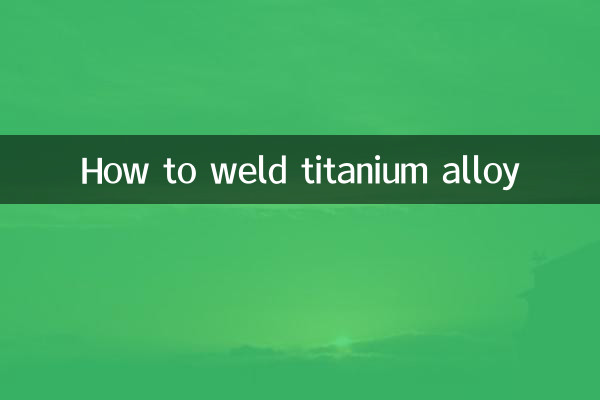How to weld titanium alloy
Titanium alloys are widely used in aerospace, medical and chemical industries due to their high strength, low density and excellent corrosion resistance. However, the welding process of titanium alloys is relatively complex and requires strict control of the welding environment and process parameters. This article will combine the hot topics and hot content on the Internet in the past 10 days to introduce in detail the welding methods, precautions and related data of titanium alloys.
1. Main methods of titanium alloy welding

Titanium alloy welding methods mainly include the following:
| Welding method | Applicable scenarios | Advantages | Disadvantages |
|---|---|---|---|
| TIG welding (tungsten inert gas welding) | Thin plate, precision welding | High weld quality and small heat affected zone | Welding speed is slow and cost is high |
| MIG welding (melting inert gas shielded welding) | Medium and thick plate welding | Fast welding speed and high efficiency | Strict requirements for gas protection |
| laser welding | High precision welding | Small heat input and small deformation | High equipment cost |
| electron beam welding | Vacuum environment welding | Weld seam depth-to-width ratio is large and quality is high | Complex equipment and high cost |
2. Things to note when welding titanium alloys
Special attention should be paid to the following points during titanium alloy welding:
1.Gas protection: Titanium alloys can easily react with oxygen, nitrogen, etc. at high temperatures, causing welds to become embrittled. Therefore, high-purity inert gas (such as argon) must be used for protection during welding, and a drag shield must be used for protection when necessary.
2.Cleaning: Before welding, it is necessary to thoroughly remove oil stains, oxides and other impurities on the surface of the workpiece to avoid pores or cracks in the weld.
3.Heat input control: The thermal conductivity of titanium alloy is low. Excessive heat input during welding can easily lead to deformation or grain coarsening, so welding parameters need to be strictly controlled.
4.Post welding treatment: After welding is completed, the weld needs to be annealed to eliminate residual stress and improve weld performance.
3. Reference process parameters for titanium alloy welding
The following are typical process parameters for TIG welding of titanium alloys:
| Material thickness (mm) | Current (A) | Voltage(V) | Gas flow (L/min) | Welding speed (mm/min) |
|---|---|---|---|---|
| 1.0 | 40-60 | 10-12 | 8-10 | 100-150 |
| 2.0 | 80-100 | 12-14 | 10-12 | 80-120 |
| 3.0 | 120-140 | 14-16 | 12-15 | 60-100 |
4. Titanium alloy welding hot content on the entire network in the past 10 days
According to recent hot topics, hot spots in the field of titanium alloy welding are mainly concentrated in the following aspects:
1.Aerospace applications: The welding technology of titanium alloys in aircraft engines and fuselage structures has attracted much attention, especially the high-precision requirements of laser welding and electron beam welding.
2.medical field: Titanium alloy is used in the welding process of artificial joints and dental implants, which requires the weld to be pollution-free and highly biocompatible.
3.Environmentally friendly welding: Technology to reduce harmful gas emissions during welding has become a hot topic, such as the use of partial vacuum welding equipment.
4.Intelligent welding: The application of robotic automatic welding systems in titanium alloy welding has gradually become popular, improving welding efficiency and consistency.
5. Summary
Titanium alloy welding is a process with high technical requirements. Appropriate welding methods need to be selected according to specific application scenarios, and process parameters and environmental conditions must be strictly controlled. With the advancement of technology, the application of titanium alloy welding in aerospace, medical and other fields will be further expanded, and intelligence and environmental protection will become the main directions of future development.

check the details

check the details